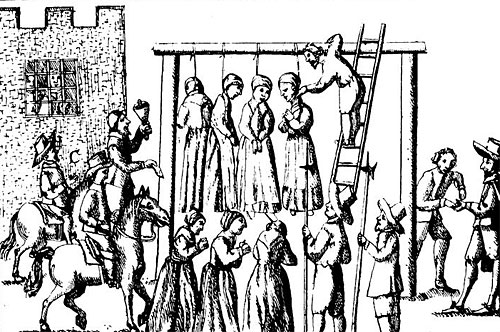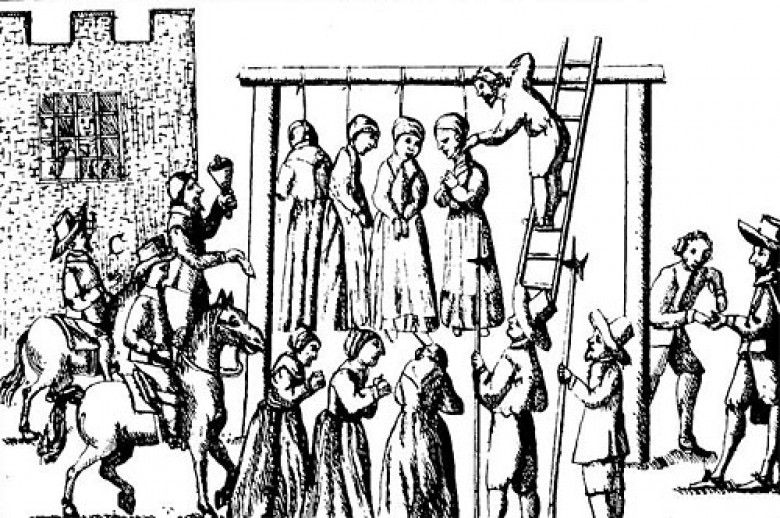10th July 2019
In a previous post, we discussed the earliest origins of witch-hunting in England and the surprisingly low numbers of people convicted of witchcraft in the Tudor period. All this was to change dramatically, however, when Elizabeth I’s successor and first cousin twice removed, James I, came to the throne in 1603.
James was well known for his interest and belief in witchcraft and sorcery – and for the persecution of witches in Scotland. During his reign, thousands of ‘witches’ were identified and tortured and the majority were killed. Records from this time are limited, however one of the most well evidenced studies, the Scottish Witchcraft Survey by the University of Edinburgh, estimates over 2,500 suspected witches were executed by strangling at the stake and their dead bodies burned. 84% of these were women. It is therefore not surprising that within a year of his accession as King of England, James introduced a more severe Witchcraft act which made almost all forms of witchcraft punishable by death. Inspired by this new act and eager to please a new King, the sudden rise in witch-hunting in England was perhaps inevitable.
Fascinatingly, though, whilst the popularity of witchcraft trials increased, James’s new act actually led to a decrease in convictions. Prior to 1604, based on the earlier law, a conviction for witchcraft could be proved by providing evidence of a connection between the suspected witch and their alleged victim. However, the new act required evidence of the witch’s association with evil spirits – a requirement that was obviously much harder to meet, unless you employ methods of torture during the investigation – as was permitted in Scotland and much of Europe. The use of torture and the resulting ‘confessions’ of engaging with the Devil gave Scotland a conviction rate of around 83% – nearly 4 times greater than the rate of convictions in England where torture of witches was not permitted.
It was during this period that one of the most famous and largest groups of people were charged and executed for witchcraft – the Pendle Witches. In early 1612 in rural Lancashire, a young woman named Alizon Device met a pedlar on her way to Trawden Forest and asked to buy some pins from him. He refused and after she left him, he suffered a fall and a fit. Alizon was subsequently accused by the pedlar’s son of using witchcraft to harm him as revenge for his refusal. It appears that Alizon was convinced that she had indeed harmed him with her thoughts and when investigated, confessed that she had been initiated into witchcraft by her maternal grandmother – the 80 year old blind widow Elizabeth Sowthernes known as ‘Old Demdike’. She also named another local elderly woman as a witch – Anne Whittle, known as ‘Old Chattox’, a known associate and sometime enemy of Demdike. Both of these women confessed to witchcraft, and Chattox also confessed to killing a father and son with magic. Demdike’s daughter (Alizon Device’s mother), Elizabeth Device, was found to have a ‘witch’s mark’ and Chattox’s daughter Anne Redfearn was also accused by Demdike. All 5 women were sent to prison in Lancaster Castle to await their trial. While they were imprisoned, a meeting at Demdike’s family home took place between other members of their families and some friends on Good Friday, at which it was alleged that they plotted to blow up the castle, release the prisoners and kill the gaoler.
The key witness in the case against the two matriarchs and their families was Demdike’s youngest granddaughter, nine year old Jennet Device who accused her mother Elizabeth of witchcraft and murder and who gave the investigators details of the plot to free her family, thus leading to the arrests of at least a further 10 people.
Old Demdike died in prison before her trial but her daughter Elizabeth, granddaughter Alizon, and grandson James, along with Old Chattox and her daughter Anne Redfearn were found guilty at Lancaster on the 17th August. This was an unusually large trial of at least 19 accused witches, over half of whom – including the original Pendle families – were hanged on the 20th August 1612.
Little more was heard of the young Jennet Device, who played such a key role in the deaths of her two siblings, mother and grandmother, until 1633 when a Pendle boy named Edmund Robinson reported being kidnapped by witches. After being taken around the area, he identified 17 alleged witches, including the now adult Jennet Device. She was found to have two witch’s marks and was convicted of killing a woman by witchcraft. She was not executed and Edmund Robinson’s story was eventually discredited, but Jennet remained in prison for several years.
After a brief decline in the 1630s, England would see witch-hunting grow to its peak in 1644-1647, mainly due to the infamous work of Matthew Hopkins – the self-styled ‘Witchfinder General’ of East Anglia.
Image: Witches being hanged, from Ralph Gardiner, England's Grievance Discovered in Relation to the Coal Trade, 1655, via Wikipedia.

